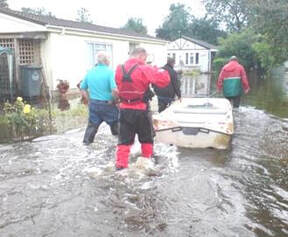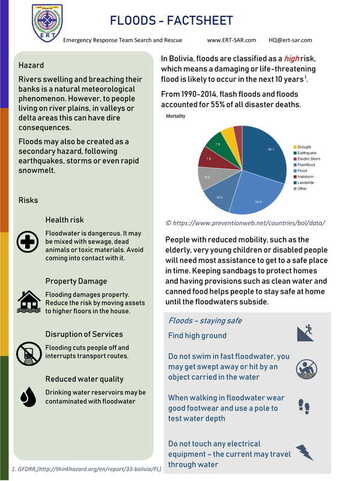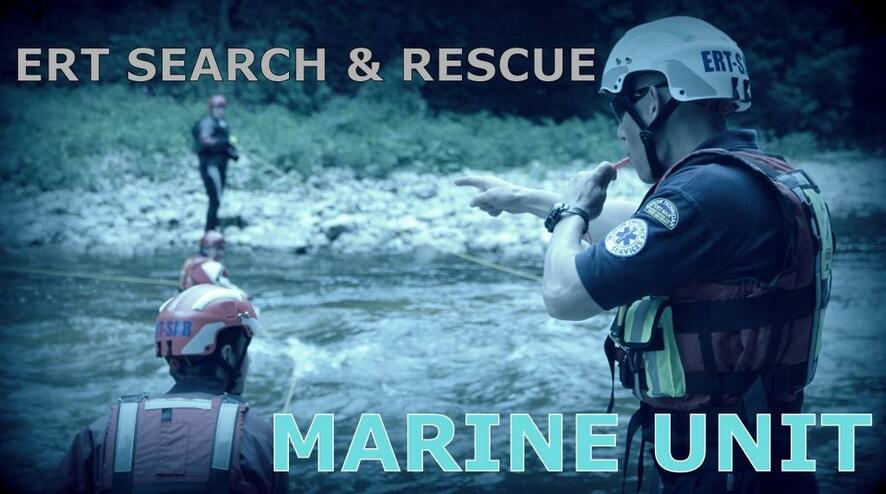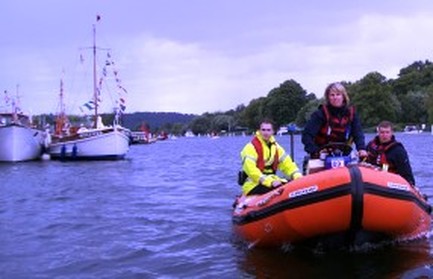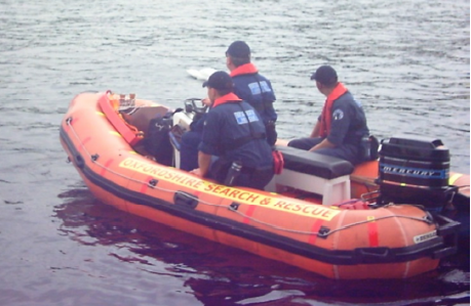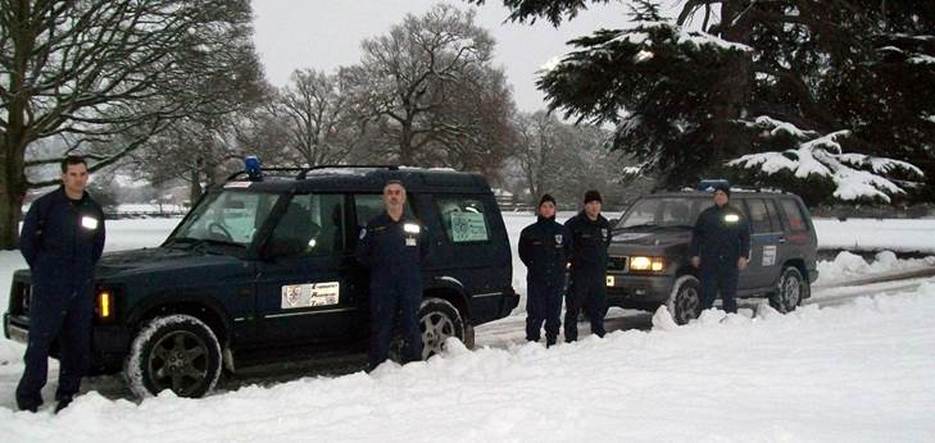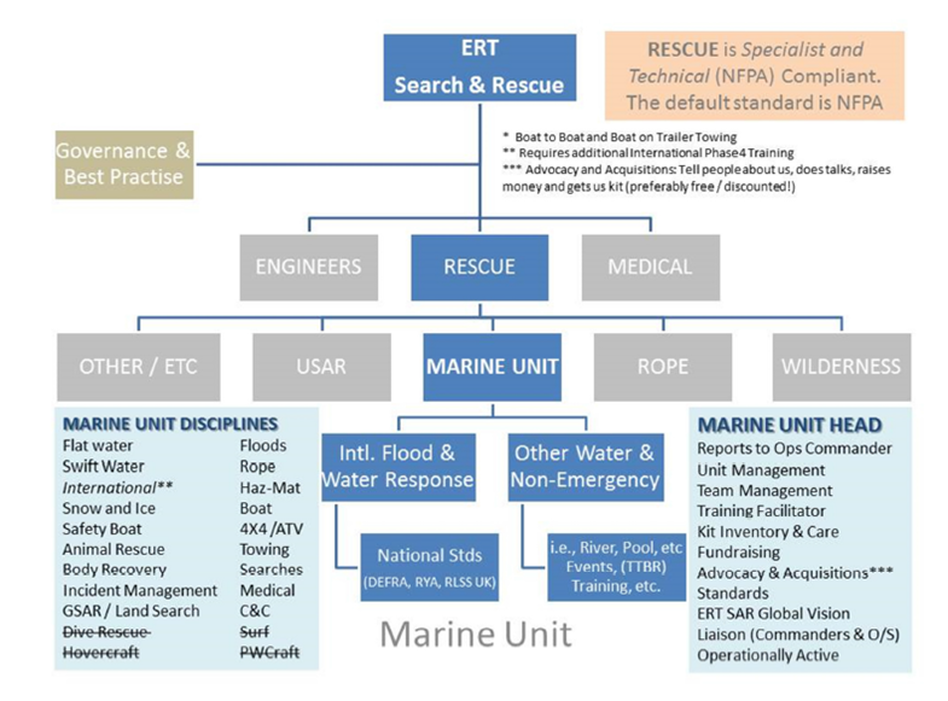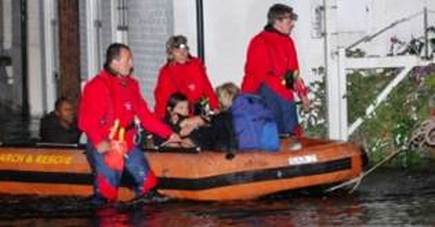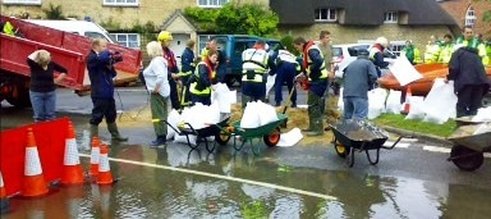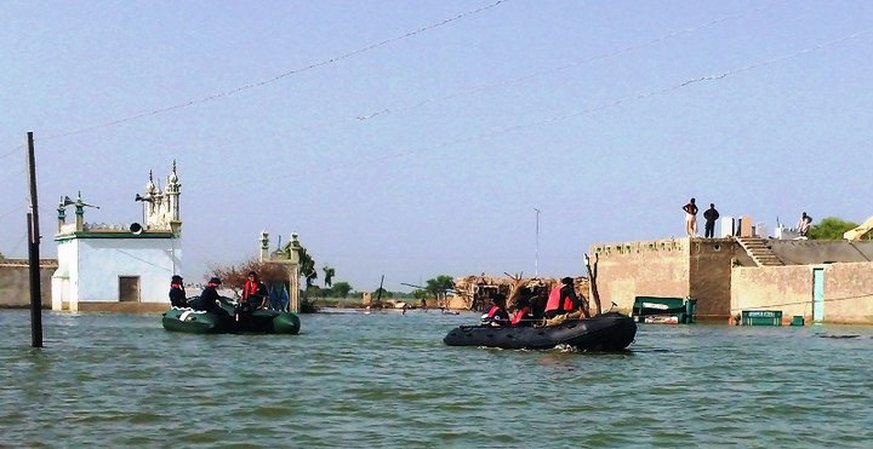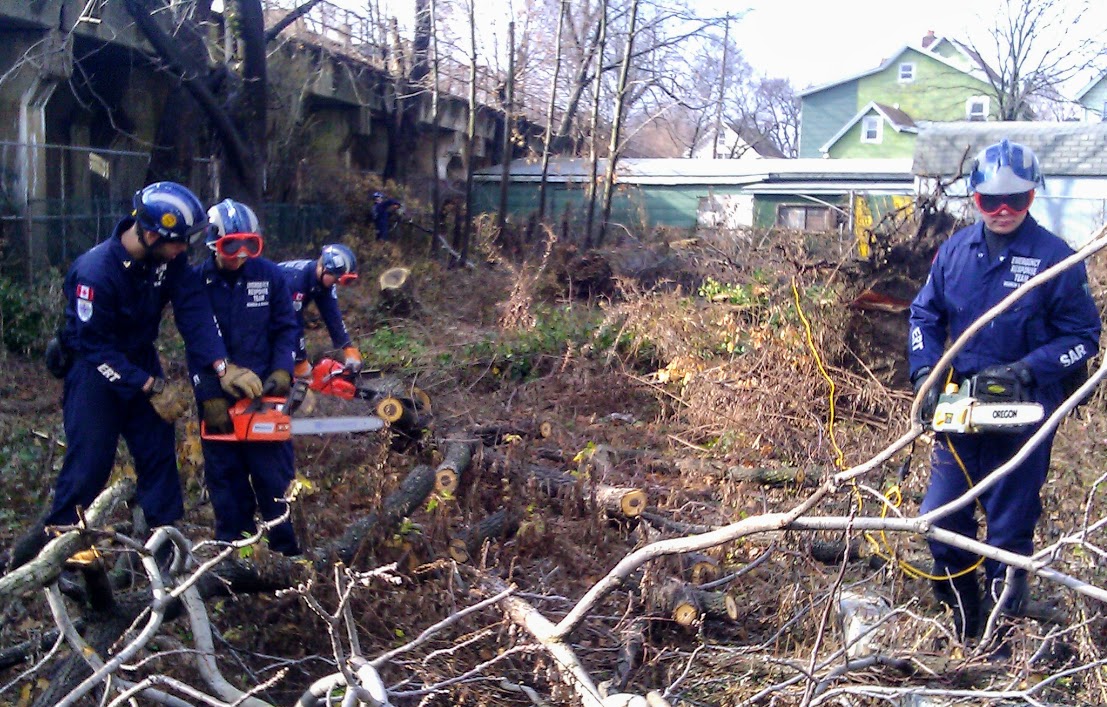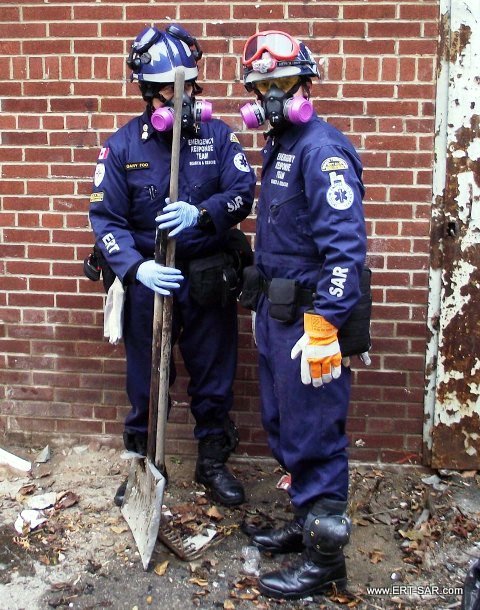The Marine Unit
Our Specialist Flood Response team is a main part of the Marine Unit. in 2019 (Operation inundatio) is a designated capacity to respond to flood disasters. #Opinundatio
From North American Fire Service NFPA 1006 / 1670 & UK DEFRA Flood and Swiftwater Rescue Technicians to Specialist Support Crews, we have been doing this a long time. Here are some of our capacity and expected services below.
From North American Fire Service NFPA 1006 / 1670 & UK DEFRA Flood and Swiftwater Rescue Technicians to Specialist Support Crews, we have been doing this a long time. Here are some of our capacity and expected services below.
|
AT TIME OF FLOOD
|
SUPPORT SYSTEMS
|
BETWEEN DISASTERS
|
Training with other agencies
ERT SAR trains with other specialists to share and develop skills, increase effectiveness, test decision making and build team cohesion and ability. In the video below ERT SAR trained with The Peel Regional Police Marine Unit and the RCAF SAR Techs.
Coxswain Andrew explains 2019 Marine Shake out scenario.
Some history and background into the specialist Rescue Division, The ERT SAR Marine Unit
MARINE UNIT PURPOSE
The Purpose of the Marine Unit is to respond to disasters and Search and Rescue (SAR) taskings or incidents involving a body of water and where their skills and assets can be utilized for an official purpose, such as floods, storms, lakes, coastal or even mud, ice and snow. The Marine Unit deals with any such "Water" capacity and that even includes connected subjects such as body recoveries or snow and Ice / 4X4 towing.
The ERT SAR Marine Unit can deploy anywhere in the world as part of the International Disaster Response ability and well as developing Resilience and Capacity Building initiatives. This is a unique skill set that augments much of the life saving with essential support services where water is concerned, whether caused by monsoon rains, tsunamis, floods, etc.
The main disciplines of the Marine Unit are listed below, however in 2018 we will be further developing this capacity.
The Marine Unit uses members from all deployable SQUADS, B to D in different capacities however to be deployable to the hot zone of a Water Rescue Incident you need to be in the H.E.A.T. Team (C Squad) or D Squad.
MARINE UNIT MAIN DISCIPLINES
(Insofar as they are related to a water based incident)
|
Flat water
|
|
Training Progression
We like members to have water rescue training and boat coxing skills but whatever their background, to join the Marine Unit they need to complete the ERT SAR MARINE UNIT PROFICIENCY (MUP) TRAINING. From water rescues to being in flood waters.
This starts with a MUP 1 - Classroom Introduction to the Marine Unit and by MUP 3 - They are doing a seies of in water training as a team. Some of the key competencies and skills from the MUP 3 - is shown in the Video Below.
This starts with a MUP 1 - Classroom Introduction to the Marine Unit and by MUP 3 - They are doing a seies of in water training as a team. Some of the key competencies and skills from the MUP 3 - is shown in the Video Below.
Contact: Marine-UK@ert-sar.com
In The U.K. ERT SAR is on the DEFRA Asset list as a Type B and Type C Team with members trained to all 6 Modules.
Contact: Marine-CA@ert-sar.com
In North America all ERT SAR related training is NFPA 1670 and NFPA 1006 Compliant (i.e., Swiftwater, Ice Rescue etc.)
|
HISTORY
We were founded in 2002 and our team were experienced rescuers and water rescuers. We boat our first powerboat in 2004 and was 17 foot long and had a 50 HP console steer engine. That year ERTSAR worked closely with the Environment Agency in the River Thames as soon after, the Thames Valley Police (from Sulhampstead) and also did events such as the Trad Boat Rally. ERT SAR has bought about 17 boats since then but we always remember our first - "SAR 1" which was retired just last year. Some of those have been donated or bought for missions and left in country and some we still own. This year (2014) we expect to buy more. We have also been generously supported by different benefactors and groups who have bought or donated kit for us. |
Our first boat when we were still known as OSAR (Oxfordshire Search and Rescue)
|
The PDC (Pacific Disaster Centre) state that Floods are one of the most common hazards on Earth and have claimed millions of lives in the past 100 years. Flooding can be triggered by heavy rainfall, tsunamis, high astronomical tides, snow melt, ice jams, prolonged strong onshore winds, or a failure of dams/levees to triggered.
ERT SAR has seen the impact and effects of water hazards and can provide a service to help people survive in a disaster and build resiliance and their local capacities as well as a service to others.
This includes our capacity to respond in (mud) snow and ice and environments with 4X4s and rescue / medical services as we have done in the past. (The picture above was take when deployed by Oxforshire FRS in Jan 2010 snow disaster.)
ERT SAR has seen the impact and effects of water hazards and can provide a service to help people survive in a disaster and build resiliance and their local capacities as well as a service to others.
This includes our capacity to respond in (mud) snow and ice and environments with 4X4s and rescue / medical services as we have done in the past. (The picture above was take when deployed by Oxforshire FRS in Jan 2010 snow disaster.)
We provided eight 4X4s and 28 members on rotating shifts a week for the Fire Service, Police and County Council.
ORGANOGRAM
The Marine Unit Structure in ERT SAR is as a specialist division of the RESCUE Section.
DUTIES AND DEPLOYMENTS
The Marine Unit had developed a unique capacity for Water based, Medical, (Flood and Water) and International deployments and have deployed nationally and internationally in this regard.
The Marine Unit had developed a unique capacity for Water based, Medical, (Flood and Water) and International deployments and have deployed nationally and internationally in this regard.
From Rescuing to Sandbagging
Pictured: ERT SAR Marine Unit members deployed to the Indus River, Pakistan during the 2010 floods.
JOINING THE MARINE UNIT
The Marine Unit is a sub-division of the ERT SAR Specialist RESCUE SECTION.
To join the Marine Unit the member should have additional training and qualifications and obviously be fitter and able to swim. usually after gaining full membership as a SAR Engineer they can express their interest and apply to join the RESCUE Section and specialize in the MARINE UNIT.
On top of the externally recognised certifications (such as Flood / Swiftwater Rescue) the member must complete the Marine Unit induction and complete quarterly sessions and skills sessions as well as team exercises.
Upon successful completion of 10 basic requirements the ERT SAR Member can earn the Marine Unit certificate and badge.
The Marine Unit is a sub-division of the ERT SAR Specialist RESCUE SECTION.
To join the Marine Unit the member should have additional training and qualifications and obviously be fitter and able to swim. usually after gaining full membership as a SAR Engineer they can express their interest and apply to join the RESCUE Section and specialize in the MARINE UNIT.
On top of the externally recognised certifications (such as Flood / Swiftwater Rescue) the member must complete the Marine Unit induction and complete quarterly sessions and skills sessions as well as team exercises.
Upon successful completion of 10 basic requirements the ERT SAR Member can earn the Marine Unit certificate and badge.
Marine Unit Logo
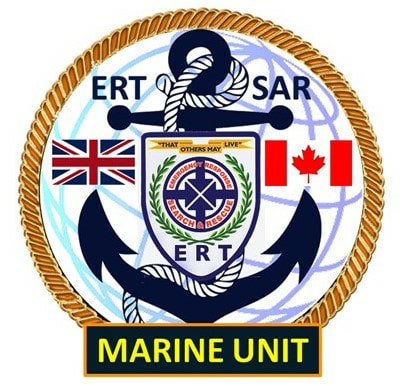
MARINE UNIT CLOTH BADGE & LOGO (2014)
The Marine Unit badge was designed at inception in 2004 and updated around 2010 and this recent badge was approved by the SAR Chief, 2014 for the 10 year anniversary.
It shows the ERT SAR shield logo over a fouled anchor showing the protection of the organisation (ERTSAR) and our partners over the unit and the integral relationship of the Marine Unit to the organisation. It is a specialist Amphibious unit and the fouled anchor behind the shield represents all aspects of the marine and water aspects - showing challenge in all endeavours such as deploying to disasters overseas or the unpredictable and threatening force of water and behind the scenes - but with success and achievement overall.
The Marine Unit badge was designed at inception in 2004 and updated around 2010 and this recent badge was approved by the SAR Chief, 2014 for the 10 year anniversary.
It shows the ERT SAR shield logo over a fouled anchor showing the protection of the organisation (ERTSAR) and our partners over the unit and the integral relationship of the Marine Unit to the organisation. It is a specialist Amphibious unit and the fouled anchor behind the shield represents all aspects of the marine and water aspects - showing challenge in all endeavours such as deploying to disasters overseas or the unpredictable and threatening force of water and behind the scenes - but with success and achievement overall.
|
The globe (in lines) behind represents the world and the international capacity of the unit and the ability to work and deploy 'anywhere' in the world and in any capacity and terrain - land, air and sea / water.
So much so that we called one of our first videos fron 2004/2005 that: By Land, By Air, By Sea. (We were called OSAR or Oxfordshire Search and Rescue for the first few years but later changed our name to ERT SAR - The Emergency Response Team SAR) The circular aspect of the twisted laid rope represents the rescue aspects of the unit and the specialists equipment of the (marine) rope. The two flags represent the founding and established countries, The UK and Canada. The blue icon centre shield represents many aspects including the 4 cardinal point of the compass and search as well as GSAR / WSAR and Air SAR. The central green crest represent medicine as well as the bravery and dedication of the members of ERT SAR. MARINE UNIT TRAINING ERT SAR Members should train regularly and attend as many sessions during the year to ensure they are current and well practised with other members of the Marine Unit. The ERT SAR Marine Unit is very unique as one of our first specialist areas and requires our Tech Rescue / Water Rescue and response members to work in with other groups such as Medics. We train very regularly year around adn as a part of the larger ERT SAR the usnit is there to support locally in our own communities or internationally to those affected and needing help at the time. ERTSAR is very qualified and experienced at doing this. Additional Media links: LT: ERT SAR training with Oxfordshire Fire & Rescue "Romeo Unit" (2007) | RT: Deployed with Gloucs FRS as a DEFRA Type B Listed Asset (2012) ERT SAR Tech. Rescue (Swiftwater Rescue) Members with the Peel Regional Police Marine Unit on Lake Ontario |
ERT SAR Storm Response Chainsaw Team.
(Everyone in this picture works for the Fire Department. That is not a requirement but from arborists to farmers to rescue techs, all our Rescuers use chainsaws. ERT SAR Disaster Clean Up Team.
This team were in dirty, wet and contaminated areas upon the request from the Government to help to help community members and emergency services in recovery. |
The proper way to sandbag in floods (Canada) #OpLentus Canadian Military Engineers
|
|
|
SOME BACKGROUND & DEPLOYMENTS
The Marine Unit is an Amphibious Unit and falls under the specialist division of our ERT SAR RESCUE Section and usually deployed in cases where water is a factor as a hazard such as lakes, rivers, canals, floods, ice, snow, mud and even storm environments. Nationally in the UK our team deployed to many emergencies including but not limited to
The Marine Unit is deployed internationally and well as nationally in response to water based events such as flooding, storms, tsunami response, etc. Such storms and floods where Marine Unit members have deployed includes the
The Marine Unit is an Amphibious Unit and falls under the specialist division of our ERT SAR RESCUE Section and usually deployed in cases where water is a factor as a hazard such as lakes, rivers, canals, floods, ice, snow, mud and even storm environments. Nationally in the UK our team deployed to many emergencies including but not limited to
- The 2007 July Floods in Oxfordshire with Oxforshire Fire and Rescue
- The 2010 Jan Snow storm in the Thames Valley (CCA 1 - OxFRS / TVP)
- The 2012 DEFRA deployment to Gloucestershire Fire and Rescue
- The 2013 DEFRA FRSNCC deployment to Norfolk at a Type B and Type C Team
- The 2014 DEFRA FRS deployments in the Home Counties
The Marine Unit is deployed internationally and well as nationally in response to water based events such as flooding, storms, tsunami response, etc. Such storms and floods where Marine Unit members have deployed includes the
- The 2004 Boxing day tsunami in Sri Lanka
- The 2010 Indus River Floods of Pakistan
- The 2012 Superstorm Sandy in New York
- The 2013 Superstorm Haiyan in the Philippines.
Good Experience & Qualified
We are not new to this. Some 19 years of ERT SAR Operations and this Flood Response video was over 14 years ago. We are up to date and well practised able to help in our communities and those abroad and proud to be able to do so.
We are not just ready to respond in boats and for floods or search and rescue but do everything from highly skilled practitioners doing home visits of medically unstable and vulnerable persons to flood clean up and recovery duties to support the community.
We are not just ready to respond in boats and for floods or search and rescue but do everything from highly skilled practitioners doing home visits of medically unstable and vulnerable persons to flood clean up and recovery duties to support the community.
SUPPORT USYour donations are appreciated!
|
JOINERTSAR ARE CURRENTLY RECRUITING VOLUNTEERS
If you are a fit healthy capable adult with no unspent Criminal Convictions and want to support our work please get in touch! |
